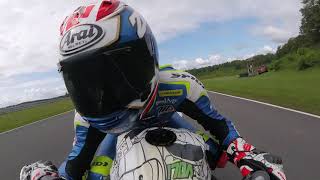In the high-stakes world of bike racing, split-second decisions can be the difference between victory and defeat. Flag recognition is a critical skill that empowers racers to interpret and respond to crucial information on the track quickly.
By developing sharp color, symbol, and pattern recognition, racers can decipher the meaning of flags with lightning speed. A red flag signaling danger, a yellow flag warning of caution, or a checkered flag indicating the race’s end are just a few examples of how these visual cues can impact a race.
Beyond basic recognition, understanding flag placement and the specific codes used in different races is essential. Quick reaction time and the ability to anticipate flag signals based on race conditions further enhance a racer’s ability to make split-second decisions. Ultimately, mastering flag recognition is a cornerstone of success, allowing riders to navigate the track with confidence and precision.
Stick around to know more!
Ways to Improve Flag Recognition Skills
Here are some strategies, drills, and exercises that can help bike racers improve their flag recognition skills:
- Color Recognition: Flags use color as a primary communication tool. To enhance color recognition, cyclists can practice associating specific colors with actions or instructions.
For instance, red often signifies danger, while yellow indicates caution. Creating flashcards with different colored flags and their corresponding meanings is a helpful training method. Regular practice improves the ability to quickly identify and respond to color-coded signals on the racecourse, ultimately enhancing race performance.
- Symbol Recognition: Flags often use symbols to convey critical race information. To excel at symbol recognition, create a comprehensive list of common flag symbols employed in bike racing. Alongside each symbol, clearly define its meaning.
Regular practice in identifying these symbols rapidly will significantly enhance your ability to interpret flag signals during a race. This skill is essential for making swift and accurate decisions under pressure.
3. Pattern Recognition: Flags often employ intricate patterns or unique color combinations to convey critical race information. To excel in pattern recognition, cyclists should familiarize themselves with various flag designs.
Understanding the meaning behind each pattern is crucial. By associating specific patterns with particular race conditions or required actions, riders can significantly enhance their reaction time. This skill is vital for making swift and accurate decisions during the heat of competition.
4. Drills and Exercises: To truly master flag recognition, bike racers can incorporate a variety of drills and exercises into their training regimen. These activities are designed to sharpen focus, improve reaction time, and solidify the understanding of flag meanings.
Practical Flag Recognition Drills
- Flag Course Navigation: This drill involves setting up a course with multiple flags placed at varying distances and intervals. Racers then navigate the course, identifying and responding to each flag as it appears. This simulates race conditions and helps develop quick decision-making skills.
- Flag Flashcard Training: Create flashcards with different flags and their corresponding meanings. Practice identifying the flags as quickly as possible. This exercise can be done individually or in groups, adding a competitive element to enhance motivation.
- Video Analysis: Watch race footage and pause at key moments where flags are displayed. Analyze the flag, its meaning, and the subsequent actions of the riders. This helps in understanding the real-world application of flag signals.
- Simulation Drills: Create simulated race scenarios using flags to practice different situations. For instance, simulate a yellow flag warning, a red flag stoppage, or a checkered flag finish. This helps in developing appropriate responses to various flag-related events.
- Team Flag Recognition Challenges: Organize team-based flag recognition competitions. Divide riders into teams and present them with a series of flags. The team that correctly identifies the most flags within a given time frame wins. This fosters a competitive and collaborative learning environment.
- Race Simulations: Participating in simulated or mock races offers an invaluable platform to hone flag recognition skills under competitive pressure. Immerse yourself in the race environment, focusing intently on the flags displayed.
Practice reacting promptly to each flag, mirroring real-race conditions. Post-simulation analysis is crucial. Evaluate your performance, identifying strengths and weaknesses in flag recognition. This reflective process aids in refining your skills, ensuring you’re prepared to excel when the actual race flag drops.
Remember that flag recognition skills can be honed through consistent practice and exposure to different flag scenarios. It’s important to familiarize yourself with the specific set of flags used in the races you participate in, as flag systems may vary between different race organizers.
Stay up to date with the rules and regulations governing flag usage in your race discipline to ensure you’re well-prepared.
Stay tuned with EvolveGT for more informative posts.




